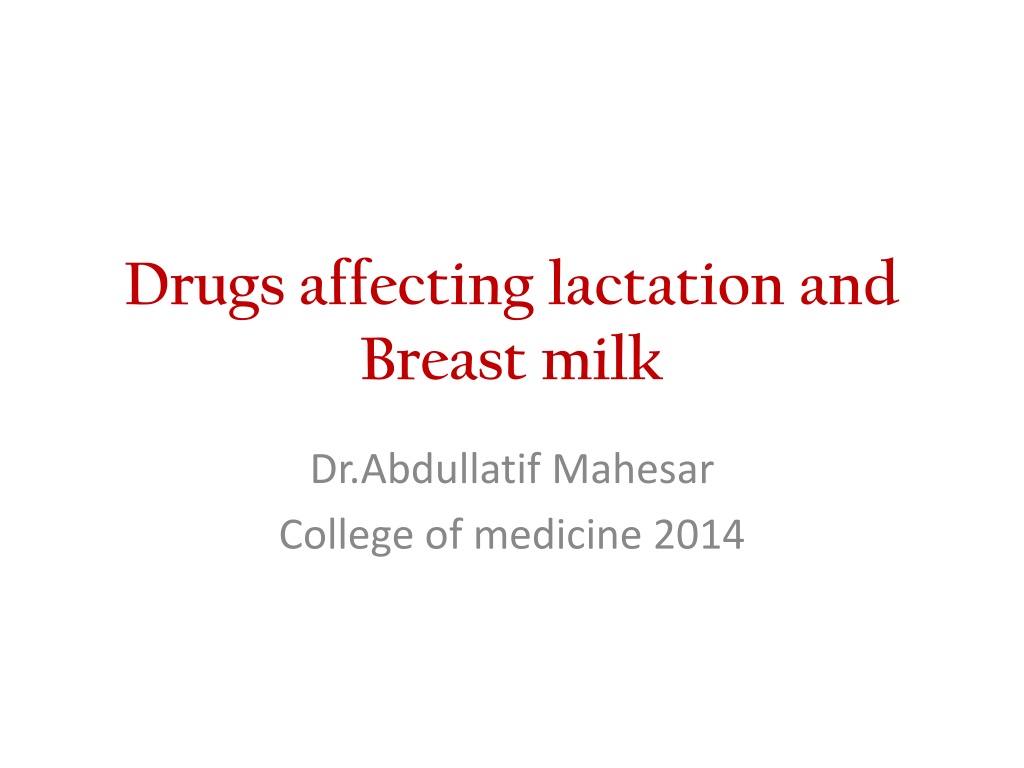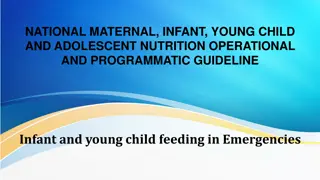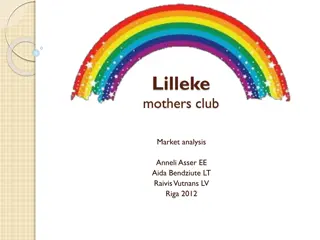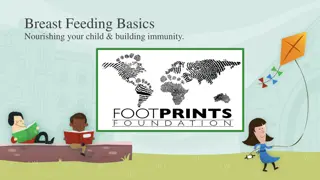Understanding Drugs and Lactation in Breastfeeding Mothers
Drugs can impact lactation and breast milk, affecting the health of both the mother and her baby. Factors such as drug passage into milk, effects on milk production, and drug safety during lactation need to be considered. The permeability of breast alveolar cells can vary, influencing drug transfer into milk, especially in the first week postpartum. Both maternal and infant factors play a role in determining the amount of drug exposure from breastfeeding.
Download Presentation

Please find below an Image/Link to download the presentation.
The content on the website is provided AS IS for your information and personal use only. It may not be sold, licensed, or shared on other websites without obtaining consent from the author. Download presentation by click this link. If you encounter any issues during the download, it is possible that the publisher has removed the file from their server.
E N D
Presentation Transcript
Drugs affecting lactation and Breast milk Dr.Abdullatif Mahesar College of medicine 2014
Intended learning issues Relation of drugs and lactation Factors modifying passage of drugs in milk Effects of drugs on milk production Role of lactation on drugs excretion Drug safety during lactation / use of safe drugs Drugs contraindicated during lactation
LACTATION Human breast milk is the healthiest form of milk for human babies. Provide the baby with immunoglobulins that are essential for protection against gastric and other infections (IgA, IgM).
DRUGS AND LACTATION Most drugs administered to breast feeding woman are detectable in milk. The concentration of drugs achieved in breast milk is usually low. how ever in certain cases presence of even small amount of drug may be considered.
BREAST FEEDING AND DRUGS The epithelium of the breast alveolar cells is most permeable to drugs during the 1st week postpartum, so drug transfer to milk may be greater during the 1stweek of an infants life.
Factors that affect passage of drugs into breast milk 1. Physiochemical character of the drug Lipid solubility Molecular weight Degree of ionization PH Plasma protein binding e.g warfarin half life of the drug diazepam volume of distribution eg. barbiturates e.g. Insulin,heparin eg. Heparin e.g oxazepam v/s
MATERNAL FACTORS Dose Routes of administration topical admin is preferable Health status of mother the epithelium of breast is most permeable during the 1stweek postpartum, drug transfer may be easier. INFANT FACTORS Premature born baby Low birth weight Health status Infant with G6PD deficiency may develop hemolysis and hyperbilirubinemia with sulphonamides and antimalarial drug primaquine
The amount of a drug to which the baby is exposed as a result of breast feeding depends on: The concentration of the drug in the milk at the time of feeding The amount of milk consumed. The amount of drug absorbed by the baby The ability of the baby to eliminate the drug.
General consideration to minimize risk to nursing infant Try breast-feeding immediately before taking a drug. Special cautions are required in Premature baby Low birth weight infant with impaired metabolism and excretory system.
General consideration to minimize the amount Choose medications with the Shortest half-life and highest protein-binding ability. With the poorest oral/systemic absorption. Medications with lowest lipid solubility.
DRUG CATEGORIES from hazardous to safer DRUG CATEGORIES Cytotoxic drugs that may interfere with cellular metabolism of the nursing infant, cause possible immune suppression, effect on growth, neutropenia and association with carcinogenesis e.g. cyclophosphamide, cyclosporine, doxorubicin, methotrexate. Drugs of abuse for which adverse effects on infant during breast feeding have been reported.eg. Amphetamine, cocaine, heroin, marijuana ,phencyclidine
Radioactive compounds, that require temporary cessation of breast feeding eg. Iodine 131. Drugs for which the effects on nursing infants is unknown but may be of concern Drugs that have been associated with significant effects on some nursing infants and should be given with nursing mothers with caution Maternal medication usually compatible with breast feeding
PRECAUTIONS DURING BREAST FEEDING Drugs with no safety data should be avoided or lactation should be discontinued. Lactating mother should take medication just after nursing and 3-4 hours before the next feeding. (to allow time for drug to be cleared from the mother s blood drug concentration in milk will be low).
AUGMENTATION OF LACTATION Persistent and active suckling release both prolactin and oxytocin to stimulate milk Secretion. Dopamine antagonists stimulate prolactin secretion as Metoclopramide Phenothiazines Haloperidol Methyl dopa Theophylline
SUPPRESSION OF LACTATION L-dopa Dopamine Bromocriptine Ergot derivatives Androgens Estrogen, oral contraceptives that contain high-dose estrogen and a progestin.
SUPPRESSION OF LACTATION Thiazide diuretics Pyridoxine MAO inhibitors
DRUGS CONTRAINDICATED DURING LACTATION 1. Radioactive drugs eg.radioactive iodine 2. Anticancer drugs Doxorubicin Cyclophosphamide Methotrexate 3. CNS acting drugs/drugs of abuse Amphetamine Heroin Cocaine 4. Ergot derivatives: eg.ergotamine 5. Lithium 6. Some antibiotics eg.chloramphenicol
Drugs to be avoided during lactation Barbiturates: Phenobarbitone Benzodiazepines:diazepam Antithyroid drugs: carbamizole Hormonal contraceptives: estrogen Analgesics :Aspirin Antibiotics: Tetracyclines























